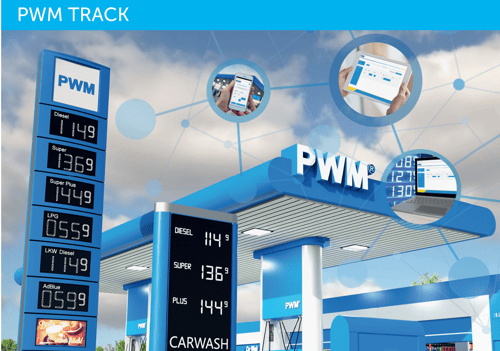Beyond Gas: How Signage Powers EV and Retail Growth

The modern fuel forecourt is evolving at a faster pace than ever. Gasoline and diesel remain part of the picture, but they’re no longer the only reason drivers stop to refuel.
Electric vehicle (EV) charging, compressed natural gas (CNG), propane (autogas), hydrogen, and bundled retail promotions are redefining what a “gas station” represents.
That shift calls for more than updated infrastructure; it requires reimagined communication. Today’s forecourt signage is no longer just a fuel price display. It’s a digital hub that connects alternative fuels, EV charging, and retail engagement into one coherent brand experience.
With advanced LED and digital price displays from PWM Electronic Price Signs, operators can do more than just show cents per gallon; they can highlight EV charging, showcase alternative fuels, and promote retail bundles that drive higher sitewide margins.
Expanding Energy Mix: From Gasoline to “Energy Retail”
Across the U.S., the number of public EV charging ports has doubled since 2021, with over 192,000 available today and approximately 1,000 new public chargers added each week.
Meanwhile, demand for alternative fuels, including biodiesel, CNG, and hydrogen, is rising, accelerated by federal incentives and shifting fleet priorities in both transportation and industry.
For forecourt operators, this expanding energy mix introduces new challenges and opportunities:
- More price points to display, covering gasoline, diesel, ethanol blends, and kilowatt-hour pricing for electric charging.
- New information needs, like charger availability, estimated charging time, and payment options for multiple energy types.
- Greater differentiation, with bundled services such as “Charge & Coffee” or “Fill & Wash” promotions that integrate energy with retail for higher margins.
Forecourt signage is now a vital engagement tool. Dynamic digital displays unify energy offerings and retail bundles, delivering a single, compelling message that keeps the site relevant and profitable.
Gas Station EV Signage: Visibility for the Next Wave of Drivers
EV drivers increasingly rely on visible, accessible cues to locate charging stations, check status, and decide where to stop, turning gas station EV signage into a critical capture tool for a fast-growing customer base.
The U.S. saw a 35 percent year-over-year increase in DC fast chargers in 2025, with station networks expanding to support millions of new EV owners.
Essential strategies for EV-ready forecourt signage include:
- Real-time charging status: Integrate digital signage with charger networks to show available ports, charging speeds, and estimated wait times, improving both charger utilization rates and customer experience.
- Unified branding: Avoid hiding EV chargers out of sight. LED displays and numeric signs, matching fuel price boards, establish a consistent site identity and emphasize the station’s dedication to “energy retail” for all vehicle types.
- Directional guidance: Digital totems or canopy-mounted signs effectively direct EV traffic to charging zones while ensuring smooth on-site movement, increasingly important as mixed-energy retailing grows.
- Dynamic pricing: For chargers using time-of-day or demand-based rates, digital signage delivers instant updates, keeping prices transparent and trust high.
Result: sites are more visible, better used, and ready for future energy retail.
Alternative Fuel Price Display: Clarity Across Every Pump
Propane, hydrogen, E85, and CNG require clear, standardized price display beyond traditional “per gallon” labels. Current standards mandate units like cents per kilowatt-hour for electricity, per gasoline gallon equivalent (GGE) for CNG, or per kilogram for hydrogen.
Advanced digital signage allows operators to:
- Show different units—¢/kWh, $/GGE, or $/kg—accurately reflecting each fuel’s industry standard.
- Display multiple fuels and prices side-by-side, with options to stack rows or use color-coded modules to eliminate confusion for mixed-energy sites.
- Incorporate certification marks and visual trust signals, such as UL listings, EPA renewable energy certificates, or clean-energy logos, for transparency and compliance.
PWM’s modular signage systems enable remote updates of labels, fonts, and colors, which can deliver standard-compliant displays for any mix of fuels and future energy products.
This adaptability lets operators respond instantly to changing products or regulations without replacing hardware.
Forecourt Digital Signage for Retail Bundles: Turning Traffic into Transactions
With margins on fuel sales thinning, the real path to profitability lies in converting forecourt traffic into in-store sales. According to industry data, three in five fuel customers also enter the store, making digital signage a powerful bridge from the pump to the retail counter.
Retailers increasingly use forecourt digital signage to prompt immediate, location-based offers that boost high-margin product sales and loyalty participation.
Examples of effective digital signage retail bundle strategies include:
- “Fuel & Food” combos: Advertise time-limited offers, like “Save 10¢ per gallon with a sandwich purchase,” directly at the pump.
- EV charging promotions: Use digital displays to offer free coffee with a 30-minute charge or share discounted car wash vouchers to charger users during dwell time.
- Loyalty tie-ins: Display QR codes linked to mobile apps for points and personalized discounts, blending digital discovery with in-store engagement.
- Cross-lane messaging: Rotate between real-time price displays and high-margin product ads, such as coffee, snacks, or car care, based on daypart or local traffic patterns.
By integrating digital signage with back-office systems, operators can dynamically schedule and target promotions for commuting peaks, lunch hours, or evening traffic, maximizing impact and relevance.
PWM’s programmable LED controller technology combines fuel price digits, bundled promotions, and animated graphics across product services such as High Rise Digits, Profitboard-LED Message Center, DOOH-IT, and others.
Why Digital Signage Drives ROI
Modern LED price displays go far beyond visual appeal; they deliver measurable return on investment for forecourts.
Key ROI factors include:
- Reduced maintenance: No more manual digit changes or on-site reprogramming. Digital price boards can be updated instantly across multiple locations, reducing labor costs and truck rolls.
- Improved accuracy: Prices and promotions are synced automatically from your CMS, minimizing errors and maintaining compliance with daily or hourly changes.
- Energy efficiency: PWM’s latest LED modules are built for long life and minimal power consumption, lowering operating costs year over year.
- Higher conversion: Dynamic, motion-based content consistently captures more customer attention and drives impulse purchases compared to static signage.
The bottom line: more customer traffic, higher average basket sizes, and a measurable boost in brand perception and profitability.
The PWM Advantage: Future-Ready Forecourt Retail
PWM Electronic Price Signs leads display technology in North America, offering SMD LED signs designed for evolving fuel types and retail models. Systems are modular, upgradable, and remotely managed for flexibility and compliance. All are engineered for high-contrast readability, durability, and reliability.
Contact PWM Electronic Price Signs today to discover how dynamic digital displays showcase EV charging, promote alternative fuels, and unlock retail growth.






